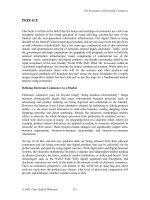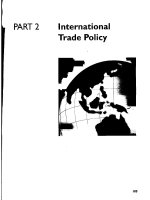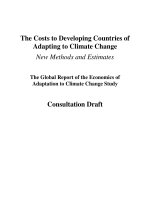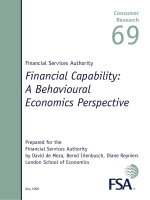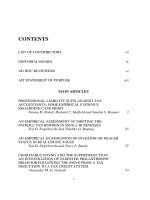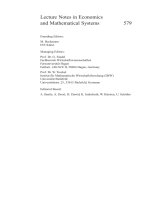Contemporary engineering economics
Bạn đang xem bản rút gọn của tài liệu. Xem và tải ngay bản đầy đủ của tài liệu tại đây (8.58 MB, 947 trang )
ParkFMff.qxd
6/2/06
2:01 PM
Page i
Contemporary
Engineering
Economics
ParkFMff.qxd
6/2/06
2:01 PM
Page ii
ParkFMff.qxd
6/2/06
2:01 PM
Page iii
Contemporary
Engineering
Economics
Fourth Edition
Chan S. Park
Depar tment of Industr ial
and Systems Engineer ing
Aubur n Univer sity
Upper Saddle River, NJ 07458
ParkFMff.qxd
6/2/06
2:01 PM
Page iv
Library of Congress Cataloging-in-Publication Data on File
Vice President and Editorial Director, ECS: Marcia J. Horton
Senior Editor: Holly Stark
Editorial Assistant: Nicole Kunzmann
Executive Managing Editor: Vince O’Brien
Managing Editor: David A. George
Production Editor: Scott Disanno
Director of Creative Services: Paul Belfanti
Creative Director: Juan López
Art Director: Heather Scott
Interior and Cover Designer: Tamara Newnam
Art Editor: Xiaohong Zhu
Manufacturing Manager: Alexis Heydt-Long
Manufacturing Buyer: Lisa McDowell
Marketing Manager: Tim Galligan
© 2007 by Pearson Education, Inc.
Pearson Prentice Hall
Upper Saddle River, New Jersey 07458
All rights reserved. No part of this book may be reproduced, in any form or by any means
without permission in writing from the publisher.
The author and publisher of this book have used their best efforts in preparing this book. These
efforts include the development, research, and testing of the theories and programs to determine
their effectiveness. The author and publisher make no warranty of any kind, expressed or
implied, with regard to these programs or the documentation contained in this book. The author
and publisher shall not be liable in any event for incidental or consequential damages in connection with, or arising out of, the furnishing, performance, or use of these programs.
Printed in the United States of America
10
9
8
7
6
5
4
3
2
1
ISBN 0-13-187628-7
Pearson Education Ltd., London
Pearson Education Australia Pte. Ltd., Sydney
Pearson Education Singapore, Pte. Ltd.
Pearson Education North Asia Ltd., Hong Kong
Pearson Education Canada, Inc., Toronto
Pearson Educación de Mexico, S.A. de C.V.
Pearson Education–Japan, Tokyo
Pearson Education Malaysia, Ptd. Ltd.
Pearson Education, Inc., Upper Saddle River, New Jersey
ParkFMff.qxd
6/2/06
2:01 PM
Page v
To my wife, Kim (Inkyung); and my children, Michael and Edward
ParkFMff.qxd
6/2/06
2:01 PM
Page vi
ParkFMff.qxd
6/2/06
2:01 PM
Page vii
CONTENTS
Preface
xix
PART 1 B ASICS OF FINANCIAL DECISIONS
Chapter 1
Engineering Economic Decisions
1
2
1.1
Role of Engineers in Business
1.1.1 Types of Business Organization
1.1.2 Engineering Economic Decisions
1.1.3 Personal Economic Decisions
4
5
6
6
1.2
What Makes the Engineering Economic Decision Difficult?
7
1.3
Economic Decisions versus Design Decisions
8
1.4
Large-Scale Engineering Projects
1.4.1 How a Typical Project Idea Evolves
1.4.2 Impact of Engineering Projects on Financial Statements
1.4.3 A Look Back in 2005: Did Toyota Make the Right Decision?
9
9
12
13
1.5
Common Types of Strategic Engineering Economic Decisions
13
1.6
Fundamental Principles of Engineering Economics
15
Summary
17
Chapter 2
Understanding Financial Statements
18
2.1
Accounting: The Basis of Decision Making
21
2.2
Financial Status for Businesses
2.2.1 The Balance Sheet
2.2.2 The Income Statement
2.2.3 The Cash Flow Statement
22
24
27
30
2.3
Using Ratios to Make Business Decisions
2.3.1 Debt Management Analysis
2.3.2 Liquidity Analysis
2.3.3 Asset Management Analysis
2.3.4 Profitability Analysis
2.3.5 Market Value Analysis
2.3.6 Limitations of Financial Ratios in Business Decisions
33
34
37
38
39
41
42
Summary
43
Problems
44
Short Case Studies
50
vii
ParkFMff.qxd
6/2/06
2:01 PM
Page viii
viii CONTENTS
Chapter 3
Interest Rate and Economic Equivalence
52
3.1
Interest: The Cost of Money
3.1.1 The Time Value of Money
3.1.2 Elements of Transactions Involving Interest
3.1.3 Methods of Calculating Interest
3.1.4 Simple Interest versus Compound Interest
54
55
56
59
62
3.2
Economic Equivalence
3.2.1 Definition and Simple Calculations
3.2.2 Equivalence Calculations: General Principles
3.2.3 Looking Ahead
63
63
66
71
3.3
Development of Interest Formulas
3.3.1 The Five Types of Cash Flows
3.3.2 Single-Cash-Flow Formulas
3.3.3 Uneven Payment Series
3.3.4 Equal Payment Series
3.3.5 Linear Gradient Series
3.3.6 Geometric Gradient Series
71
72
73
80
84
96
102
3.4
Unconventional Equivalence Calculations
3.4.1 Composite Cash Flows
3.4.2 Determining an Interest Rate to Establish Economic Equivalence
107
107
114
Summary
119
Problems
119
Short Case Studies
129
Chapter 4
Understanding Money and Its Management
134
4.1
Nominal and Effective Interest Rates
4.1.1 Nominal Interest Rates
4.1.2 Effective Annual Interest Rates
4.1.3 Effective Interest Rates per Payment Period
4.1.4 Continuous Compounding
136
136
137
140
141
4.2
Equivalence Calculations with Effective Interest Rates
4.2.1 When Payment Period Is Equal to Compounding Period
4.2.2 Compounding Occurs at a Different Rate than that at
Which Payments Are Made
143
144
Equivalence Calculations with Continuous Payments
4.3.1 Single-Payment Transactions
4.3.2 Continuous-Funds Flow
152
152
152
4.3
145
ParkFMff.qxd
6/2/06
2:01 PM
Page ix
Contents ix
4.4
Changing Interest Rates
4.4.1 Single Sums of Money
4.4.2 Series of Cash Flows
156
156
158
4.5
Debt Management
4.5.1 Commercial Loans
4.5.2 Loan versus Lease Financing
4.5.3 Home Mortgage
159
159
167
171
4.6
Investing in Financial Assets
4.6.1 Investment Basics
4.6.2 How to Determine Your Expected Return
4.6.3 Investing in Bonds
175
175
176
179
Summary
187
Problems
188
Short Case Studies
199
PART 2 EVALUATION OF BUSINESS
AND ENGINEERING ASSETS
Chapter 5
5.1
Present-Worth Analysis
203
204
Describing Project Cash Flows
5.1.1 Loan versus Project Cash Flows
5.1.2 Independent versus Mutually Exclusive
Investment Projects
207
207
5.2
Initial Project Screening Method
5.2.1 Payback Period: The Time It Takes to Pay Back
5.2.2 Benefits and Flaws of Payback Screening
5.2.3 Discounted Payback Period
5.2.4 Where Do We Go from Here?
210
210
213
214
215
5.3
Discounted Cash Flow Analysis
5.3.1 Net-Present-Worth Criterion
5.3.2 Meaning of Net Present Worth
5.3.3 Basis for Selecting the MARR
215
216
220
222
5.4
Variations of Present-Worth Analysis
5.4.1 Future-Worth Analysis
5.4.2 Capitalized Equivalent Method
223
223
227
5.5
Comparing Mutually Exclusive Alternatives
5.5.1 Meaning of Mutually Exclusive and “Do Nothing”
5.5.2 Analysis Period
232
232
235
209
ParkFMff.qxd
6/2/06
2:01 PM
Page x
x CONTENTS
5.5.3 Analysis Period Equals Project Lives
5.5.4 Analysis Period Differs from Project Lives
5.5.5 Analysis Period Is Not Specified
236
238
246
Summary
249
Problems
249
Short Case Studies
265
Chapter 6
Annual Equivalent-Worth Analysis
268
6.1
Annual Equivalent-Worth Criterion
6.1.1 Fundamental Decision Rule
6.1.2 Annual-Worth Calculation with Repeating Cash Flow Cycles
6.1.3 Comparing Mutually Exclusive Alternatives
270
270
273
275
6.2
Capital Costs versus Operating Costs
277
6.3
Applying Annual-Worth Analysis
6.3.1 Benefits of AE Analysis
6.3.2 Unit Profit or Cost Calculation
6.3.3 Make-or-Buy Decision
6.3.4 Pricing the Use of an Asset
280
281
281
283
286
6.4
Life-Cycle Cost Analysis
287
6.5
Design Economics
294
Summary
303
Problems
304
Short Case Studies
318
Chapter 7
Rate-of-Return Analysis
322
7.1
Rate of Return
7.1.1 Return on Investment
7.1.2 Return on Invested Capital
324
324
326
7.2
Methods for Finding the Rate of Return
7.2.1 Simple versus Nonsimple Investments
7.2.2 Predicting Multiple i*’s
7.2.3 Computational Methods
327
327
329
331
7.3
Internal-Rate-of-Return Criterion
7.3.1 Relationship to PW Analysis
7.3.2 Net-Investment Test: Pure versus Mixed Investments
7.3.3 Decision Rule for Pure Investments
7.3.4 Decision Rule for Mixed Investments
338
338
339
341
344
ParkFMff.qxd
6/2/06
2:01 PM
Page xi
Contents xi
7.4
Mutually Exclusive Alternatives
7.4.1 Flaws in Project Ranking by IRR
7.4.2 Incremental Investment Analysis
7.4.3 Handling Unequal Service Lives
352
352
353
360
Summary
363
Problems
364
Short Case Studies
381
PART 3 ANALY SIS OF PROJECT C ASH FLOWS
Chapter 8
Cost Concepts Relevant to Decision Making
385
386
8.1
General Cost Terms
8.1.1 Manufacturing Costs
8.1.2 Nonmanufacturing Costs
388
388
390
8.2
Classifying Costs for Financial Statements
8.2.1 Period Costs
8.2.2 Product Costs
390
391
391
8.3
Cost Classification for Predicting Cost Behavior
8.3.1 Volume Index
8.3.2 Cost Behaviors
394
394
395
8.4
Future Costs for Business Decisions
8.4.1 Differential Cost and Revenue
8.4.2 Opportunity Cost
8.4.3 Sunk Costs
8.4.4 Marginal Cost
400
400
404
406
406
8.5
Estimating Profit from Production
8.5.1 Calculation of Operating Income
8.5.2 Sales Budget for a Manufacturing Business
8.5.3 Preparing the Production Budget
8.5.4 Preparing the Cost-of-Goods-Sold Budget
8.5.5 Preparing the Nonmanufacturing Cost Budget
8.5.6 Putting It All Together: The Budgeted Income Statement
8.5.7 Looking Ahead
411
412
412
413
415
416
418
419
Summary
420
Problems
421
Short Case Study
427
ParkFMff.qxd
6/2/06
2:01 PM
Page xii
xii CONTENTS
Chapter 9
Depreciation and Corporate Taxes
428
9.1
Asset Depreciation
9.1.1 Economic Depreciation
9.1.2 Accounting Depreciation
431
432
432
9.2
Factors Inherent in Asset Depreciation
9.2.1 Depreciable Property
9.2.2 Cost Basis
9.2.3 Useful Life and Salvage Value
9.2.4 Depreciation Methods: Book and Tax Depreciation
433
433
434
435
436
9.3
Book Depreciation Methods
9.3.1 Straight-Line Method
9.3.2 Accelerated Methods
9.3.3 Units-of-Production Method
437
437
439
445
9.4
Tax Depreciation Methods
9.4.1 MACRS Depreciation
9.4.2 MACRS Depreciation Rules
446
446
447
9.5
Depletion
9.5.1 Cost Depletion
9.5.2 Percentage Depletion
453
453
454
9.6
Repairs or Improvements Made to Depreciable Assets
9.6.1 Revision of Book Depreciation
9.6.2 Revision of Tax Depreciation
456
456
457
9.7
Corporate Taxes
9.7.1 Income Taxes on Operating Income
459
459
9.8
Tax Treatment of Gains or Losses on Depreciable Assets
9.8.1 Disposal of a MACRS Property
9.8.2 Calculations of Gains and Losses on MACRS Property
462
462
464
9.9
Income Tax Rate to Be Used in Economic Analysis
9.9.1 Incremental Income Tax Rate
9.9.2 Consideration of State Income Taxes
467
467
470
9.10
The Need for Cash Flow in Engineering Economic Analysis
9.10.1 Net Income versus Net Cash Flow
9.10.2 Treatment of Noncash Expenses
472
472
473
Summary
476
Problems
478
Short Case Studies
487
ParkFMff.qxd
6/2/06
2:01 PM
Page xiii
Contents xiii
Chapter 10
Developing Project Cash Flows
490
10.1
Cost–Benefit Estimation for Engineering Projects
10.1.1 Simple Projects
10.1.2 Complex Projects
492
493
493
10.2
Incremental Cash Flows
10.2.1 Elements of Cash Outflows
10.2.2 Elements of Cash Inflows
10.2.3 Classification of Cash Flow Elements
494
494
495
497
10.3
Developing Cash Flow Statements
10.3.1 When Projects Require Only Operating and Investing Activities
10.3.2 When Projects Require Working-Capital Investments
10.3.3 When Projects Are Financed with Borrowed Funds
10.3.4 When Projects Result in Negative Taxable Income
10.3.5 When Projects Require Multiple Assets
498
498
502
507
509
513
10.4
Generalized Cash Flow Approach
10.4.1 Setting up Net Cash Flow Equations
10.4.2 Presenting Cash Flows in Compact Tabular Formats
10.4.3 Lease-or-Buy Decision
516
517
518
520
Summary
524
Problems
525
Short Case Studies
537
PART 4 HANDLING RISK AND UNCERTAINTY
Chapter 11
541
Inflation and Its Impact on Project Cash Flows
542
11.1
Meaning and Measure of Inflation
11.1.1 Measuring Inflation
11.1.2 Actual versus Constant Dollars
544
544
550
11.2
Equivalence Calculations under Inflation
11.2.1 Market and Inflation-Free Interest Rates
11.2.2 Constant-Dollar Analysis
11.2.3 Actual-Dollar Analysis
11.2.4 Mixed-Dollar Analysis
553
553
553
554
558
11.3
Effects of Inflation on Project Cash Flows
11.3.1 Multiple Inflation Rates
11.3.2 Effects of Borrowed Funds under Inflation
558
562
563
ParkFMff.qxd
6/2/06
2:01 PM
Page xiv
xiv CONTENTS
11.4
Rate-of-Return Analysis under Inflation
11.4.1 Effects of Inflation on Return on Investment
11.4.2 Effects of Inflation on Working Capital
566
566
569
Summary
572
Problems
574
Short Case Studies
582
Chapter 12
Project Risk and Uncertainty
584
12.1
Origins of Project Risk
586
12.2
Methods of Describing Project Risk
12.2.1 Sensitivity Analysis
12.2.2 Break-Even Analysis
12.2.3 Scenario Analysis
587
587
591
594
12.3
Probability Concepts for Investment Decisions
12.3.1 Assessment of Probabilities
12.3.2 Summary of Probabilistic Information
12.3.3 Joint and Conditional Probabilities
12.3.4 Covariance and Coefficient of Correlation
596
596
601
603
605
12.4
Probability Distribution of NPW
12.4.1 Procedure for Developing an NPW Distribution
12.4.2 Aggregating Risk over Time
12.4.3 Decision Rules for Comparing Mutually Exclusive
Risky Alternatives
605
605
611
12.5
Risk Simulation
12.5.1 Computer Simulation
12.5.2 Model Building
12.5.3 Monte Carlo Sampling
12.5.4 Simulation Output Analysis
12.5.5 Risk Simulation with @RISK
618
619
620
623
628
630
12.6
Decision Trees and Sequential Investment Decisions
12.6.1 Structuring a Decision-Tree Diagram
12.6.2 Worth of Obtaining Additional Information
12.6.3 Decision Making after Having Imperfect
Information
633
634
639
Summary
647
Problems
648
Short Case Studies
658
616
642
ParkFMff.qxd
6/2/06
2:01 PM
Page xv
Contents xv
Chapter 13
Real-Options Analysis
664
13.1
Risk Management: Financial Options
13.1.1 Buy Call Options when You Expect the Price to Go Up
13.1.2 Buy Put Options when You Expect the Price to Go Down
666
669
669
13.2
Option Strategies
13.2.1 Buying Calls to Reduce Capital That Is at Risk
13.2.2 Protective Puts as a Hedge
670
670
673
13.3
Option Pricing
13.3.1 Replicating-Portfolio Approach with a Call Option
13.3.2 Risk-Free Financing Approach
13.3.3 Risk-Neutral Probability Approach
13.3.4 Put-Option Valuation
13.3.5 Two-Period Binomial Lattice Option Valuation
13.3.6 Multiperiod Binomial Lattice Model
13.3.7 Black–Scholes Option Model
675
675
677
679
680
681
683
684
13.4
Real-Options Analysis
13.4.1 A Conceptual Framework for Real Options
in Engineering Economics
13.4.2 Types of Real-Option Models
686
13.5
13.6
687
688
Estimating Volatility at the Project Level
13.5.1 Estimating a Project’s Volatility through a
Simple Deferral Option
13.5.2 Use the Existing Model of a Financial Option to Estimate σ2
697
699
Compound Options
703
Summary
708
Problems
709
Short Case Studies
713
697
PART 5 SPECIAL TOPICS IN ENGINEERING
ECONOMICS 715
Chapter 14
14.1
Replacement Decisions
716
Replacement Analysis Fundamentals
14.1.1 Basic Concepts and Terminology
14.1.2 Opportunity Cost Approach to Comparing
Defender and Challenger
718
718
721
ParkFMff.qxd
6/2/06
2:01 PM
Page xvi
xvi CONTENTS
14.2
Economic Service Life
723
14.3
Replacement Analysis when the Required Service Is Long
14.3.1 Required Assumptions and Decision Frameworks
14.3.2 Replacement Strategies under the Infinite Planning Horizon
14.3.3 Replacement Strategies under the Finite Planning Horizon
14.3.4 Consideration of Technological Change
728
729
730
735
738
14.4
Replacement Analysis with Tax Considerations
739
Summary
755
Problems
756
Short Case Studies
768
Chapter 15
Capital-Budgeting Decisions
776
15.1
Methods of Financing
15.1.1 Equity Financing
15.1.2 Debt Financing
15.1.3 Capital Structure
778
779
780
782
15.2
Cost of Capital
15.2.1 Cost of Equity
15.2.2 Cost of Debt
15.2.3 Calculating the Cost of Capital
787
787
792
794
15.3
Choice of Minimum Attractive Rate of Return
15.3.1 Choice of MARR when Project Financing Is Known
15.3.2 Choice of MARR when Project Financing Is Unknown
15.3.3 Choice of MARR under Capital Rationing
795
795
797
799
15.4
Capital Budgeting
15.4.1 Evaluation of Multiple Investment Alternatives
15.4.2 Formulation of Mutually Exclusive Alternatives
15.4.3 Capital-Budgeting Decisions with Limited Budgets
803
803
803
805
Summary
809
Problems
810
Short Case Studies
816
Chapter 16
16.1
Economic Analysis in the Service Sector
What Is the Service Sector?
16.1.1 Characteristics of the Service Sector
16.1.2 How to Price Service
822
824
825
825
ParkFMff.qxd
6/2/06
2:01 PM
Page xvii
Contents xvii
16.2
Economic Analysis in Health-Care Service
16.2.1 Economic Evaluation Tools
16.2.2 Cost-Effectiveness Analysis
16.2.3 How to Use a CEA
826
827
828
829
16.3 Economic Analysis in the Public Sector
16.3.1 What Is Benefit–Cost Analysis?
16.3.2 Framework of Benefit–Cost Analysis
16.3.3 Valuation of Benefits and Costs
16.3.4 Quantifying Benefits and Costs
16.3.5 Difficulties Inherent in Public-Project Analysis
832
833
833
834
836
840
16.4 Benefit–Cost Ratios
16.4.1 Definition of Benefit–Cost Ratio
16.4.2 Relationship between B/C Ratio and NPW
16.4.3 Comparing Mutually Exclusive Alternatives:
Incremental Analysis
840
840
843
16.5 Analysis of Public Projects Based on Cost-Effectiveness
16.5.1 Cost-Effectiveness Studies in the Public Sector
16.5.2 A Cost-Effectiveness Case Study
846
847
847
843
Summary
856
Problems
857
Short Case Studies
862
Appendix A
Index
899
Interest Factors for Discrete Compounding
869
ParkFMff.qxd
6/2/06
2:01 PM
Page xviii
ParkFMff.qxd
6/2/06
2:01 PM
Page xix
PREFACE
What is “Contemporary” About Engineering Economics?
Decisions made during the engineering design phase of product development determine
the majority of the costs associated with the manufacturing of that product (some say that
this value may be as high as 85%). As design and manufacturing processes become more
complex, engineers are making decisions that involve money more than ever before. With
more than 80% of the total GDP (Gross Domestic Product) in the United States provided
by the service sector, engineers work on various economic decision problems in the service sector as well. Thus, the competent and successful engineer in the twenty-first century
must have an improved understanding of the principles of science, engineering, and economics, coupled with relevant design experience. Increasingly, in the new world economy,
successful businesses will rely on engineers with such expertise.
Economic and design issues are inextricably linked in the product/service life cycle.
Therefore, one of my strongest motivations for writing this text was to bring the realities
of economics and engineering design into the classroom and to help students integrate
these issues when contemplating many engineering decisions. Of course my underlying
motivation for writing this book was not simply to address contemporary needs, but to
address as well the ageless goal of all educators: to help students to learn. Thus, thoroughness, clarity, and accuracy of presentation of essential engineering economics were
my aim at every stage in the development of the text.
Changes in the Fourth Edition
Much of the content has been streamlined to provide materials in depth and to reflect the
challenges in contemporary engineering economics. Some of the highlighted changes are
as follows:
• Chapter 13 “Real Options Analysis” is new and provides a new perspective on how
engineers should manage risk in their strategic economic decision problems.
Traditionally, risk is avoided in project analysis, which is a passive way of handling
the matter. The goal of the real options approach is to provide a contemporary tool
that will assist engineers so that they can actively manage the risk involved in longterm projects.
• Chapter 12 has been significantly revised to provide more probabilistic materials for
the analytical treatment of risk and uncertainty. Risk simulation has been introduced
by way of using @RISK.
• Three chapters have been merged with various materials from other chapters.
Chapter 3 on cost concepts and behaviors has been moved to Part III and now
appears as Chapter 8 “Cost Concepts Relevant to Decision Making”; it is now part
of project cash flow analysis. Chapter 6 on principles of investing is now part of
Chapter 4 “Understanding Money and Its Management.” Materials from various
chapters have been merged into a single chapter and now appear as Chapter 9
“Depreciation and Corporate Income Taxes”.
• The chapter on the economic analysis in the public sector has been expanded and now
appears as Chapter 16 “Economic Analysis in the Service Sector”; this revised chapter now provides economic analysis unique to service sectors beyond the government
xix
ParkFMff.qxd
6/2/06
2:01 PM
Page xx
xx PREFACE
•
•
•
•
sector. Increasingly, engineers seek their career in the service sector, such as healthcare, financial institutions, transportation, and logistics. In this chapter, we present
some unique features that must be considered when evaluating investment projects in
the service sector.
All the end-of-chapter problems are revised to reflect the materials changes in the
main text.
All the chapter opening vignettes—a trademark of Contemporary Engineering
Economics—have been completely replaced with more current and thought-provoking
case studies.
Self-study problems and FE practice questions are available as interactive quizzes
with instant feedback as part of the book’s new OneKey CourseCompass site.
OneKey is an online resource for instructors and students; more detailed information
about OneKey can be found in the OneKey section of this Preface. OneKey can be
accessed via www.prenhall.com/onekey.
Various Excel spreadsheet modeling techniques are introduced throughout the chapters and the original Excel files are provided online at the OneKey site .
Overview of the Text
Although it contains little advanced math and few truly difficult concepts, the introductory engineering economics course is often a curiously challenging one for the
sophomores, juniors, and seniors who take it. There are several likely explanations for
this difficulty.
1. The course is the student’s first analytical consideration of money (a resource with
which he or she may have had little direct contact beyond paying for tuition, housing, food, and textbooks).
2. The emphasis on theory may obscure for the student the fact that the course aims,
among other things, to develop a very practical set of analytical tools for measuring project worth. This is unfortunate since, at one time or another, virtually every
engineer—not to mention every individual—is responsible for the wise allocation
of limited financial resources.
3. The mixture of industrial, civil, mechanical, electrical, and manufacturing engineering, and other undergraduates who take the course often fail to “see themselves” in the skills the course and text are intended to foster. This is perhaps less
true for industrial engineering students, whom many texts take as their primary
audience, but other disciplines are often motivationally shortchanged by a text’s
lack of applications that appeal directly to them.
Goal of the Text
This text aims not only to provide sound and comprehensive coverage of the concepts of
engineering economics but also to address the difficulties of students outlined above, all
of which have their basis in inattentiveness to the practical concerns of engineering economics. More specifically, this text has the following chief goals:
1. To build a thorough understanding of the theoretical and conceptual basis upon
which the practice of financial project analysis is built.
ParkFMff.qxd
6/2/06
2:01 PM
Page xxi
Preface
2. To satisfy the very practical needs of the engineer toward making informed financial decisions when acting as a team member or project manager for an engineering
project.
3. To incorporate all critical decision-making tools—including the most contemporary, computer-oriented ones that engineers bring to the task of making informed
financial decisions.
4. To appeal to the full range of engineering disciplines for which this course is often
required: industrial, civil, mechanical, electrical, computer, aerospace, chemical,
and manufacturing engineering, as well as engineering technology.
Prerequisites
The text is intended for undergraduate engineering students at the sophomore level or
above. The only mathematical background required is elementary calculus. For Chapters
12 and 13, a first course in probability or statistics is helpful but not necessary, since the
treatment of basic topics there is essentially self-contained.
Taking Advantage of the Internet
The integration of computer use is another important feature of Contemporary Engineering
Economics. Students have greater access to and familiarity with the various spreadsheet
tools, and instructors have greater inclination either to treat these topics explicitly in the
course or to encourage students to experiment independently.
A remaining concern is that the use of computers will undermine true understanding of course concepts. This text does not promote the use of trivial spreadsheet applications as a replacement for genuine understanding of and skill in applying traditional
solution methods. Rather, it focuses on the computer’s productivity-enhancing benefits
for complex project cash flow development and analysis. Specifically, Contemporary
Engineering Economics includes a robust introduction to computer automation in the
form of Computer Notes, which are included in the optional OneKey course
(www.prenhall.com/onekey).
Additionally, spreadsheets are introduced via Microsoft Excel examples. For spreadsheet coverage, the emphasis is on demonstrating a chapter concept that embodies some
complexity that can be much more efficiently resolved on a computer than by traditional
longhand solutions.
OneKey
Available as a special package, OneKey is Prentice Hall’s exclusive new resource for
instructors and students. Instructors have access online to all available course supplements
and can create and assign tests, quizzes, or graded homework assignments. Students have
access to interactive exercises, quizzes, and more. The following resources are available
when an instructor adopts the text plus OneKey package:
• Interactive self-study quizzes organized by chapter with instant feedback, plus interactive FE Exam practice questions
• Computer notes with Excel files of selected example problems from the text.
• Case Studies: A collection of actual cases, two personal-finance and six industrybased, is now available. The investment projects detailed in the cases relate to a
xxi
ParkFMff.qxd
6/2/06
2:01 PM
Page xxii
xxii PREFACE
variety of engineering disciplines. Each case is based on multiple text concepts, thus
encouraging students to synthesize their understanding in the context of complex,
real-world investments. Each case begins with a list of engineering economic concepts utilized in the case and concludes with discussion questions to test students’
conceptual understanding.
• Analysis Tools: A collection of various financial calculators is available. Cash Flow
Analyzer is an integrated online Java program that is menu driven for convenience
and flexibility; it provides (1) a flexible and easy-to-use cash flow editor for data
input and modifications, and (2) an extensive array of computational modules and
user-selected graphic outputs.
• Instructor Resources: Instructors Solutions Manual, PowerPoint Lecture Notes,
Case Studies and more.
Please contact your Prentice Hall representative for details and ordering information
for OneKey packages. Detailed instructions about how to access and use this content can
be found at the site, which can be accessed at: www.prenhall.com/onekey.
The Financial Times
We are please to announce a special partnership with The Financial Times. For a small
additional charge, Prentice Hall offers students a 15-week subscription to The Financial
Times. Upon adoption of a special package containing the book and the subscription
booklet, professors will receive a free one-year subscription. Please contact your Prentice
Hall representative for details and ordering information.
Acknowledgments
This book reflects the efforts of a great many individuals over a number of years. In particular, I would like to recognize the following individuals, whose reviews and comments
on prior editions have contributed to this edition. Once again, I would like to thank each
of them:
Kamran Abedini, California Polytechnic–Pomona
James Alloway, Syracuse University
Mehar Arora, U. Wisconsin–Stout
Joel Arthur, California State University–Chico
Robert Baker, University of Arizona
Robert Barrett, Cooper Union and Pratt Institute
Tom Barta, Iowa State University
Charles Bartholomew, Widener University
Richard Bernhard, North Carolina State University
Bopaya Bidanda, University of Pittsburgh
James Buck, University of Iowa
Philip Cady, The Pennsylvania State University
Tom Carmichal, Southern College of Technology
Jeya Chandra, The Pennsylvania State University
ParkFMff.qxd
6/2/06
2:01 PM
Page xxiii
Preface
Max C. Deibert, Montana State University
Stuart E. Dreyfus, University of California, Berkeley
Philip A. Farrington, University of Alabama at Huntsville
W. J. Foley, RPI
Jane Fraser, University of Southern Colorado
Terry L Friesz, Penn State University
Anil K. Goyal, RPI
Bruce Hartsough, University of California, Davis
Carl Hass, University of Texas, Austin
John Held, Kansas State University
T. Allen Henry, University of Alabama
R.C. Hodgson, University of Notre Dame
Scott Iverson, University of Washington
Peter Jackson, Cornell University
Philip Johnson, University of Minnesota
Harold Josephs, Lawrence Tech
Henry Kallsen, University of Alabama
W. J. Kennedy, Clemson University
Oh Keytack, University of Toledo
Wayne Knabach, South Dakota State University
Stephen Kreta, California Maritime Academy
John Krogman, University of Wisconsin–Platteville
Dennis Kroll, Bradley University
Michael Kyte, University of Idaho
Gene Lee, University of Central Florida
William Lesso, University of Texas–Austin
Martin Lipinski, Memphis State University
Robert Lundquist, Ohio State University
Richard Lyles, Michigan State University
Gerald T. Mackulak, Arizona State University
Abu S. Masud, The Wichita State University
Sue McNeil, Carnegie-Mellon University
James Milligan, University of Idaho
Richard Minesinger, University of Massachusetts, Lowell
Gary Moynihan, The University of Alabama
James S. Noble, University of Missouri, Columbia
Michael L. Nobs, Washington University, St. Louis
Wayne Parker, Mississippi State University
Elizabeth Pate-Cornell, Stanford University
Cecil Peterson, GMI
George Prueitt, U.S. Naval Postgraduate School
J.K. Rao, California State University-Long Beach
Susan Richards, GMI
Bruce A. Reichert, Kansas State University
Mark Roberts, Michigan Tech
John Roth, Vanderbilt University
Paul L. Schillings, Montana State University
xxiii
ParkFMff.qxd
6/2/06
2:01 PM
Page xxiv
xxiv PREFACE
Bill Shaner, Colorado State University
Fred Sheets, California Polytechnic, Pomona
Dean Shup, University of Cincinnati
Milton Smith, Texas Tech
David C. Slaughter, University of California, Davis
Charles Stavridge, FAMU/FSU
Junius Storry, South Dakota State University
Frank E. Stratton, San Diego State University
George Stukhart, Texas A&M University
Donna Summers, University of Dayton
Joe Tanchoco, Purdue University
Deborah Thurston, University of Illinois at Urbana-Champaign
Lt. Col. James Treharne, U.S. Army
L. Jackson Turaville, Tennessee Technological University
Thomas Ward, University of Louisville
Theo De Winter, Boston University
Yoo Yang, Cal Poly State University
Special Acknowledgement
Personally, I wish to thank the following individuals for their additional inputs to the
fourth edition: Michael L. Nobs, Washington University, St. Louis, Terry L. Friesz, Penn
State University, Gene Lee, University of Central Florida, Gerald T. Mackulak, Arizona
State University, and Phillip A. Farrington, University of Alabama, Huntsville. Major
Hyun Jin Han who helped me in developing the Instructor Manual; Holly Stark, my editor at Prentice Hall, who assumed responsibility for the overall project; Scott Disanno,
my production editor at Prentice Hall, who oversaw the entire book production. I also
acknowledge that many of the financial terminologies found in the marginal notes are
based on the online glossary defined by Investopedia and Investorwords.com. Finally, I
would like to thank Dr. Alice E. Smith, Chair of Industrial & Systems Engineering at
Auburn University, who provided me with the resources.
CHAN S. PARK
AUBURN, ALABAMA
ParkCh01ff.qxd
5/25/06
9:02 PM
Page 1
P A R T
1
Basics of Financial
Decisions
